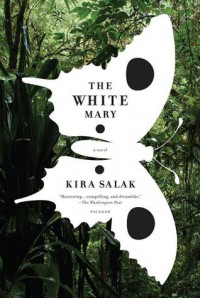

Marika Vecera is a young war reporter, recently back from the Congo and venturing into the first serious relationship of her life, when she hears the news that Robert Lewis has committed suicide. Lewis was a famous war correspondent and a hero to Marika, and as she begins working on his biography she gets word from a missionary who claims to have seen Lewis alive. Astounded, Marika uproots her life in Boston and heads to Papua New Guinea--the world's least explored frontier--to uncover the truth. Encountering all the dangers of jungle travel and the haunting mythology of native tribes, Marika's search for Lewis becomes an unforgettable journey into the depths of the human soul.
Amazon.com
War correspondent Marika gets word that her journalist idol, Robert Lewis, whose last known whereabouts were believed to be somewhere in Papua New Guinea, has committed suicide. Completely stunned and blindsided by the news, Marika decides to start work on a definitive bio on Lewis' life as a way to channel her grief. In the process of starting work on this book, she gets new information saying that Lewis might in fact still be alive, rumors surfacing that he had been spotted by villagers after his alleged suicide. Needing answers as to what is really going on, Marika decides to head into the interior jungles of Papua New Guinea to try to track down Lewis (or at least hopefully find out what the real story is). She meets up with a Anasi tribe believed to be some of the last people to have seen Lewis alive. Some of the men from the tribe start calling Marika wait meri, meaning "white mary" or white woman. The tribe's witch doctor, Tobo, claims he knows where Lewis is but at first refuses to say more, other than to insist it is too far into the jungle and much too treacherous a journey for a woman. After some discussion and haggling back and forth, Marika does end up finding a way to get Tobo to escort her himself to where he believes Lewis might be.
I really liked the premise of this novel and was even more excited to get into it after reading that the author herself is a journalist and former editor for National Geographic Magazine as well as being the first woman (or at least the first documented woman?) to have crossed all of Papua New Guinea. I thought this would bring a real true-to-life perspective to the storyline.
As a whole, I really enjoyed it! There were a few bummers for me. Seb, Marika's psych major boyfriend, seemed like a good guy most of the time but whenever he went into his periods of unrelenting analyzing of all of Marika's moods and actions, those parts got on my nerves. The action dragged in a few parts, got a little long on the inner reflection bits for my tastes, but that's just me I think. Also, the timeline of the story I found really jarring -- there's an afterword section where Salak explains why she wanted to lay out the story the way she did... and I get it (sort of) ... but I don't know, I feel like the story could have made sense just as easily if the reader could have been given something more chronological to follow rather than jumping back and forth between present moment and one of Marika's random memories with little to no reference or background given to the reader.
Also, I gotta say, this book had one of the most horrific scenes of terrorism I've read, involving the slow torture, rape and murder of a young girl used to prove a point and get information out of a grown man. That scene alone had me thinking that I don't think I could ever give this book a re-read. Just left me stunned. Glad I read the story, but I feel like I have enough struggles with chronic depression without repeatedly revisiting that imagery.
That being said, I really enjoyed the relationships between Marika and all villagers she comes to know. I wasn't sure if I liked Tobo at first but by the end I got where he was coming from and found myself totally on Team Tobo :-)
Note To Readers: If you'd like to learn a little backstory on the making of this novel, you can check out Salak's blog here, where she shares photos of the places and people that inspired The White Mary.

 1
1








